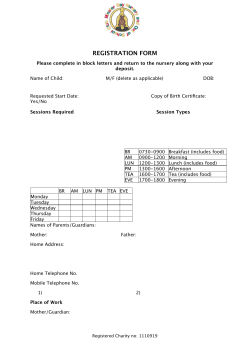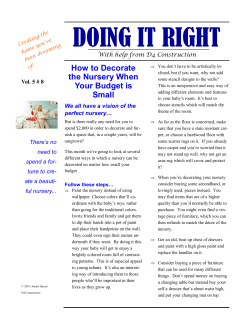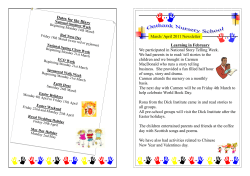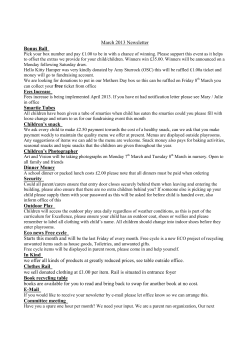
Tropical Nursery Manual A Guide to Starting and Operating a
Tropical Nursery Manual A Guide to Starting and Operating a Nursery for Native and Traditional Plants U.S. Department of Agriculture, Forest Service Agriculture Handbook 732 April 2014 Edited by Kim M. Wilkinson Thomas D. Landis Diane L. Haase Brian F. Daley R. Kasten Dumroese The use of trade or firm names in this publication is for reader information and does not imply endorsement by the U.S. Department of Agriculture, Forest Service of any product or service. Pesticides used improperly can be injurious to humans, animals, and plants. Follow the directions and heed all precautions on the labels. Store pesticides in original containers under lock and key—out of the reach of children and animals—and away from food and feed. Apply pesticides so that they do not endanger humans, livestock, crops, beneficial insects, fish, and wildlife. Do not apply pesticides when there is danger of drift, when honey bees or other pollinating insects are visiting plants, or in ways that may contaminate water or leave illegal residues. Avoid prolonged inhalation of pesticide sprays or dusts; wear protective clothing and equipment if specified on the container. If your hands become contaminated with a pesticide, do not eat or drink until you have washed. In case a pesticide is swallowed or gets in the eyes, follow the first-aid treatment given on the label, and get prompt medical attention. If a pesticide is spilled on your skin or clothing, remove clothing immediately and wash skin thoroughly. Do not clean spray equipment or dump excess spray material near ponds, streams, or wells. Because it is difficult to remove all traces of herbicides from equipment, do not use the same equipment for insecticides or fungicides that you use for herbicides. Dispose of empty pesticide containers promptly. Have them buried at a sanitary landfill dump, or crush and bury them in a level, isolated place. NOTE: Some States have restrictions on the use of certain pesticides. Check your State and local regulations. Also, because registrations of pesticides are under constant review by the Federal Environmental Protection Agency, consult your county agricultural agent or State extension specialist to be sure the intended use is still registered. The U.S. Department of Agriculture (USDA) prohibits discrimination in all its programs and activities on the basis of race, color, national origin, age, disability, and where applicable, sex, marital status, familial status, parental status, religion, sexual orientation, genetic information, political beliefs, reprisal, or because all or part of an individual’s income is derived from any public assistance program. (Not all prohibited bases apply to all programs.) Persons with disabilities who require alternative means for communication of program information (Braille, large print, audiotape, etc.) should contact USDA’s TARGET Center at (202) 720-2600 (voice and TDD). To file a complaint of discrimination, write USDA, Director, Office of Civil Rights, 1400 Independence Avenue, S.W., Washington, D.C. 20250-9410, or call (800) 795-3272 (voice) or (202) 720-6382 (TDD). USDA is an equal opportunity provider and employer. Nomenclature for scientific names follows the U.S. Department of Agriculture, Natural Resources Conservation Service PLANTS (Plant List of Accepted Nomenclature, Taxonomy, and Symbols) database (2008). http://plants.usda.gov. Cover photo credits (left to right, top to bottom): Brian F. Daley, Jill Wagner, Brian F. Daley, Thomas D. Landis, George Hernández, Jill Wagner, Diane L. Haase, Brian F. Daley, and Thomas D. Landis. Back cover photo credits (top to bottom): Brian F. Daley, © Jack Jeffrey Photography, Tara Luna, Diane L. Haase, and J.B. Friday. iv About the Authors Brian F. Daley is a forest ecologist in the U.S. Virgin Islands. He was the Agroforestry Research Specialist for the University of the Virgin Islands for 10 years. While he was at the university, he developed native tree propagation protocols and low-cost “gap-planting” methods using native plants to enrich degraded dry forests dominated by exotic plants. His research includes landcover change analysis of St. Croix using Landsat and focusing on the relationship between forests, agriculture, and development. He is currently a senior partner with Geographic Consulting, LLC, a natural resources management company with projects ranging from phytoremediation of contaminated industrial sites to sea turtle nesting research and writing legislation. R. Kasten Dumroese is the U.S. Department of Agriculture (USDA), Forest Service National Nursery Specialist and a research plant physiologist in the Rocky Mountain Research Station. His background as a nursery manager and researcher shapes his philosophy that nursery production problems are simply “unsolved opportunities.” His research focuses on collecting, growing, and outplanting native plants; removing bottlenecks to efficient plant production and quality; and correctly using native plants in response to climate change and to restore ecosystem function. In 2000, he initiated the Native Plants Journal and the Native Plant Network; this journal and searchable Internet database foster sharing of information about growing and planting native flora. Diane L. Haase is the USDA Forest Service Western Nursery Specialist, providing technical expertise to nurseries in the 17 Western States and the Pacific islands. Through publications, presentations, conferences, workshops, and on-site visits, Diane assists nursery managers and other plant professionals in improving nursery growing practices, increasing seedling quality, and maximizing plant growth and survival after outplanting. She has published numerous scientific articles and technical papers and is a co-author of the book Propagation of Pacific Northwest Native Plants. In addition, she is the Editor for Tree Planters’ Notes, a journal focused on nursery production and outplanting of trees, shrubs, and native plants for reforestation, conservation, and restoration. Douglass F. Jacobs is the Fred M. van Eck Professor of Forest Biology in the Department of Forestry and Natural Resources at Purdue University. He is the Editor-in-Chief of New Forests, an international journal on the biology, biotechnology, and management of afforestation and reforestation. His research explores eco-physiological development of young trees in response to culture and environmental stresses. He teaches conceptual thinking and problemsolving skills relevant to the multifaceted, fluid decisionmaking process of operational management for nurseries and land managers. Having worked in Hawai‘i for more than 10 years, he was closely involved in the formation of the Tropical Hardwood Tree Improvement and Regeneration Center. David P. Janos is Professor and Cooper Fellow in the Department of Biology, University of Miami. His specialties are ecology, mycology, and tropical botany, and his research concerns the ecophysiology of mycorrhizae—mutualistic symbioses between fungi and the roots of vascular plants. The objective of his work is to understand the biology of mycorrhizae in natural ecosystems so that they can be exploited for human benefit in sustainable forest management, polycultural agriculture, and reforestation. As a former managing editor of the journal Mycorrhiza, he has worked extensively with the mycorrhizae of tropical tree seedlings in Costa Rica, Panama, and Australia. Thomas D. Landis was the National Nursery Specialist for the USDA Forest Service; he taught a series of tropical nursery training sessions in Hawai‘i, American Samoa, and Micronesia. In 2003, he invited Wilkinson, Luna, and Jacobs to participate in teaching a tropical nursery workshop that was so successful that it became the impetus for this book. Landis has authored many articles and books on nursery technology including Forest Nursery Notes and the Container Tree Nursery Manual series, which helped promote key nursery concepts including the target seedling and propagation protocols. After retiring, he has continued to work as a consultant specializing in writing and training projects concerning nurseries, reforestation, and restoration. Tara Luna is a botanist and ecologist involved in the conservation and restoration of ecologically significant areas. She specializes in documenting plant species and plant community diversity on indigenous lands, including helping to locate, protect, and restore areas with rare and culturally significant species. She has worked with American Indian tribes in the Western United States and has also taught native plant nursery short courses in the tropical Pacific. She edited Nursery Manual for Native Plants: A Guide for Tribal Nurseries and has authored native plant propagation, conservation, and restoration publications for the Native Plants Journal, USDA Forest Service and Foreign Agriculture Service, and Montana Natural Heritage Program. Kim M. Wilkinson is a social ecologist who works with ecological restoration and cultural renewal, helping bring back native and traditional plants, as well as human connections to them. She worked for 10 years in Hawai‘i as the owner/operator of a nursery for native and traditional trees. She also focused on applying traditional Polynesian agroforestry practices to sustainable farm and forestry planning. She continues to work at the intersections of food security, ecosystem restoration, and human health. She has authored several books, including Agroforestry Guides for Pacific Islands; Growing Koa: A Hawaiian Legacy Tree; and Other Voices, Other Ways, Better Practices: Bridging Local & Professional Environmental Knowledge. xi Acknowledgments The U.S. Department of Agriculture (USDA), Forest Service funded this project. Primary funding was provided by State and Private Forestry, Cooperative Forestry, through the Virtual Center for Reforestation, Nurseries, and Genetics Resources (RNGR). The Rocky Mountain Research Station also supported this effort. Jim Marin provided graphic design and layout with unfailing skill, patience, and attention to detail. Richard Zabel, Western Forestry and Conservation Association, through an agreement with the RNGR team, was instrumental in developing this manual. J.B. Friday, College of Tropical Agriculture and Human Resources, University of Hawai‘i generously shared his expertise, insights, and many excellent photographs. Jill Wagner of Future Forests Nursery, Hawai‘i, contributed photographs and her expertise on nursery management and seed saving. Craig Elevitch of Agroforestry Net, Hawai‘i, provided photographs and his expertise in traditional trees, agroforestry, and nursery development. Ray D. Rodríguez Colón, Fideicomiso de Conservación de Puerto Rico, graciously hosted visits to his country’s nurseries and gave insightful input. Dania Rivera Ocasio, University of Puerto Rico, facilitated nursery visits. Michael Morgan of the University of the Virgin Islands made many thoughtful contributions. Vital review, fact-checking, or information was provided by: Robert L. James, USDA Forest Service (retired); Mike Amaranthus, Mycorrhizal Applications, Inc.; Jim Trappe, Oregon State University; RNGR team members George Hernández, Ron Overton, and Jeremiah R. Pinto; and Margie V. Cushing Falanruw, Institute of Pacific Islands Forestry, Yap Institute of Natural Science. Krystal Beley provided consultation on photograph use and caption clarity. We thank Katie Friday, USDA Forest Service Institute of Pacific Islands Forestry for contributing photographs and information and assisting with the tropical nursery training session that first brought our authoring team together. We are grateful to the many individuals across the tropical nursery community and other professionals who helped create this publication: American Samoa: Aitasi Sameli, Endangered Plant Program; Forestry staff, American Samoa Community College; Guam: David Limtiaco, USDA Forest Service; Guam Forestry staff; Hawai‘i: Rick xii Barboza, Hui Kū Maoli Ola Native Plant Nursery; Mike Donoho, Pu‘u Wa‘awa‘a Forest Reserve; John L. Edson, Hawai‘i Reforestation Nursery; Jack Jeffrey Photography; Baron Horiuchi and his nursery staff, U.S. Department of the Interior (DOI), U.S. Fish & Wildlife Service Hakalau Forest National Wildlife Refuge; Joy Hosokawa, DOI National Park Service Volcanoes National Park; Mark and K.B. Kimball, Holualoa Tree Farm; Elliott Parsons, Pu‘u Wa‘awa‘a Forest Reserve; Ethan Romanchak, Native Nursery; Matt Schriman, Hui Kū Maoli Ola Native Plant Nursery; Jacob Witcraft and his nursery staff, Kamuela State Tree Nursery; Aileen Yeh, Po Wai U Nursery; Jim Ferrell, Mitiku Habte, Harold Keyser, and James Leary (University of Hawai’i); Patty Moriyasu (Volcano Rare Plant Facility); Idaho: J. Chris Hoag, USDA Natural Resources Conservation Service; Mississippi: J.A. Vozzo, USDA Forest Service Southern Research Station (retired); New York: Kenneth Mudge, Cornell University; Oregon: Bruce McDonald and Timber Press, Inc.; David Steinfeld, USDA Forest Service Pacific Northwest Region; Palau: Palau Forestry staff; Puerto Rico: Alberto Areces, Parque Dona Ines; Christian Torres Santana, USDA Forest Service International Institute of Tropical Forestry; U.S. Virgin Islands: Jovan Augustin, Geographic Consulting, Errol Chichester, Virgin Islands Department of Agriculture; Christina Gasperi, Art Farm; Veronica Gordon, Virgin Islands Department of Agriculture; David Hamada, St. George Village Botanical Garden; Cynthia Holmes, Cruzan Gardens; Dean Yanez (Geographic Consulting, LLC); Vanessa Forbes, Dexter Hipolit, and Paulino “Papo” Perez (University of the Virgin Islands); Yap: Staffs at Yap Forestry, USDA Forest Service Institute of Pacific Islands Forestry, Yap Institute of Natural Science. We also thank the many individuals who were photographed working in the nursery, planting in the field, or attending a training session. We are grateful to the teachers, mentors, and plant propagators from earlier times, whose names we may not know but who protected and passed down knowledge of the native and traditional plants we enjoy today. Introduction Who Is This Handbook For? What’s in This Handbook? This handbook was written for anyone endeavoring to start and operate a nursery for native and traditional plants in the tropics. Because the tropics cover a vast area of the world, however, the scope of the handbook is geared toward readers in the U.S. affiliated tropics. Specifically, the U.S. affiliated tropics are a diverse area spanning two oceans and half the globe, including the nations of the Federated States of Micronesia, the Republic of Palau, and the Republic of the Marshall Islands, as well as the Territory of Guam, the Commonwealth of the Northern Mariana Islands, the Territory of American Samoa, the Commonwealth of Puerto Rico, the U.S. Virgin Islands, and the State of Hawai‘i, southern California, Texas, and the southern part of Florida (see map on following page). Areas with similar conditions may also be served. This handbook is not a species-by-species account, though propagation protocols for many tropical species are available on the Native Plant Network (http://www.nativeplantnetwork.org). A nursery is a web of interrelated factors, and every aspect of the nursery will affect everything else. Therefore, this handbook covers topics from initial nursery founding and planning through crop production, outplanting, and ongoing learning. The important roles tropical nurseries play in ecological restoration and human well-being (Chapter 1) are discussed before going into the details of nursery site selection and planning (Chapter 2). Then, the focus shifts to what species and stocktypes the nursery will provide to best serve different projects and objectives (Chapter 3). The practicalities of planning crops, scheduling production activities, and developing ways to grow new crops is discussed (Chapter 4). Crop growth relies on good design of propagation environments (Chapter 5) and other infrastructure, including choices of growing media (Chapter 6) and appropriate containers (Chapter 7). Plant propagation includes collecting, processing, and storing seeds (Chapter 8), germinating and sowing seeds (Chapter 9), and vegetative propagation (Chapter 10). Plant care includes water quality and irrigation management (Chapter 11), plant nutrition (Chapter 12), working with beneficial organisms (Chapter 13), and holistic prevention and management of pests and diseases (Chapter 14). As crops get closer to being ready for the field, nursery management continues with hardening (Chapter 15), care in harvesting and shipping of nursery crops (Chapter 16), and finally, outplanting onto field sites and monitoring the results (Chapter 17). The chapters in this handbook discuss aspects of nursery management, providing an overview of the factors to consider when planning or upgrading a nursery. Key concepts and processes are presented, based on proven techniques, practices, and the best science available at the time of this writing. An understanding of some of these concepts and principles will make it easier to operate a nursery successfully, to serve clients, and to meet project objectives in the field. At the same time, every nursery is unique. Local conditions and ingenuity, combined with these basic principles, will shape the best practices for any given nursery. Information in this handbook is meant to provide an empowering overview of concepts and principles. Each reader is free to adapt, adopt, or disregard this information, as appropriate to their situation. The goal of this handbook is to provide practical, user-friendly, science-based, and locally adaptable information about how to start, operate, or upgrade a nursery for native and traditional plants in the tropics. All these activities combine to produce the best quality plants with the best chance to survive and flourish on outplanting sites. It is important, however, not to become so focused on production that other key aspects of nursery planning and management are neglected. Equally important is time building relationships with customers, the community, nursery staff, and other colleagues. These activities include training and education for nursery staff and outreach and education to clients and the public (Chapter 18). Overseeing nursery operations pulls many of the previous topics together as the nursery gains momentum in its operations (Chapter 19). Running a nursery is a continuous learning process and in-house research, trials, and feedback systems help improve plant productivity to expand on successes and learn from failures over time xiii (Chapter 20). Best efforts in each of these areas of tropical nursery management serve ecological, cultural, and economic goals to protect and restore native and traditional ecosystems and agroecosystems. This handbook emphasizes principles and processes for successful nursery operations that can be adapted as appropriate to each nursery’s context. We hope you find this handbook to be a useful reference for your nursery and restoration work in the tropics. Tropical Forests of the United States and Affiliated Islands Adapted from USDA Forest Service, State and Private Forestry (2007) and Arbor Day Foundation (2006). Zone Average Anual Low 16 0° 0'0 " W -40˚F through -50˚F -30˚F through -40˚F -20˚F through -30˚F -10˚F through -20˚F 6 7 8 9 Tropical 10 40˚F through 30˚F 0˚F through -10˚F 10˚F through 0˚F 20˚F through 10˚F 30˚F through 20˚F 15 7° 30'0" W State of Hawaii K au ai 21°3 0'0 " N 2 3 4 5 ! O a hu Lih ue 21°3 0'0 " N Maui 170 M les i Ha w aii ! 19°0'0 " N Hilo 19°0'0 " N 16 0° 0'0 " W 15 7° 30'0" W 67°0'0 " W 66°0'0 " W 13 4° 30'0" E 8°0'0" N 8°0'0" N 19°0'0 " N Commonwealth of Puerto Rico 19°0'0 " N 20 Miles 14 5° 30'0" E Republic of Palau 18°0'0 " N 15°1 2'0 " N C ha lan K an o a 18°0'0 " N 15°1 2'0 " N ! 80 Miles S aip a n 67°0'0 " W 7°3 0'0 " N Sa n Jos e 14 4° 36'0" E ! 65°0'0 " W 14 4° 54'0" E Guam Koror 14°4 2'0 " N 14°4 2'0 " N Commonwealth of the Northern Mariana islands St. Thomas Yig o ! Mil es T amu nin g ^_ ! ! H ag at na 13°2 7'0 " N ! Miles 7°0'0" N 13°2 7'0 " N Tropical Island Associates 14°1 2'0 " N 14 0° 0'0 " E ! 11°0'0 " N So ng so ng 15 0° 0'0 " E 16 0° 0'0 " E Federated States of Micronesia !! Y ap 660 1°0'0" N xiv 14°1 2'0 " N 14 4° 36'0" E 14 5° 30'0" E 15 5° 0'0 " E 16 0° 0'0 " E ! 16 5° 0'0 " E Miles 65°0'0 " W 17 0° 30'0" W 17 5° 0'0 " E 64°3 0'0 " W 17 0° 0'0 " W 16 9° 30'0" W Republic of the Marshall Islands 11°0'0 " N Ko lon ia Ofu-O lose g a 11°0'0 " N 11°0'0 " N 14°1 8'0 " S Kosr ae ! ! ! Miles 6°0'0" N 16 0° 0'0 " E 16 5° 0'0 " E 17 0° 0'0 " E Ofu Olosega ! 30 17 5° 0'0 " E Miles 17 0° 30'0" W Ta'u 14°1 8'0 " S 6°0'0" N 15 5° 0'0 " E ! Aunu`u AjiltakeIne Ine ! !! Anekirea Ajaltokr ok 640 U tw a M a 16 0° 0'0 " E American Samoa Tutuila Pago Pago 1°0'0" N 15 0° 0'0 " E 18°0'0 " N 25 St. Croix 14 4° 54'0" E 17 0° 0'0 " E ! Miles US Virgin Islands 18°0'0 " N Me rizo Pohnp ei Chuuk 14 0° 0'0 " E Ag at Rota 13 4° 30'0" E 64°3 0'0 " W St. John 10 25 7°0'0" N 66°0'0 " W Tinia n ! 7°3 0'0 " N 17 0° 0'0 " W 16 9° 30'0" W The development of most nursery crops can be divided into three phases: establishment, rapid growth, and hardening. Adapted from Dumroese and others (2008) by Jim Marin. References Arbor Day Foundation. 2006. Hardiness zone map. http://www.arborday.org/media/zones.cfm. (October 2011). Dumroese, R.K.; Luna, T.; Landis, T.D. 2008. Nursery manual for native plants: volume 1, a guide for tribal nurseries. Agriculture Handbook 730. Washington, DC: U.S. Department of Agriculture, Forest Service. 302 p. U.S. Department of Agriculture, Forest Service, State and Private Forestry, Program Redesign Committee. 2007. Tropical forests of the United States: applying U.S. Department of Agriculture, State and Private Forestry programs. http://www.hawaiistateassessment. info/library/tropicalforests-of-the-United-States-Final60607.pdf. (November 2011). xv
© Copyright 2025









